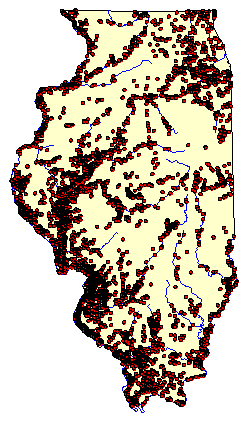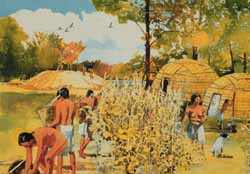
 |
|
Map of Illinois showing locations of Woodland sites |
Archaeologists have recorded 7,748 Woodland sites in Illinois. When divided by the length of the Woodland period-1,750 years-there are 4.4 Woodland sites per year. In contrast to the Archaic Period, the ratio of Woodland sites is almost four times as great. Again, archaeologists attribute some of this difference to an increase in population. What is not yet clear is to what extent population grew before the development of plant cultivation. One thing is clear; cultivation provided a more stable food supply which, in turn, led to population growth, in part, by reducing the number of infants who died. Perhaps the most critical time in a baby's life is the switch from mother's milk to solid food. Plant foods made into soups or gruels provided a nutritious and digestible food source for weaning the child from mother's milk.
Early Woodland settlements were concentrated along major river valleys. Archaeologists studying the banks of the Illinois River in central Illinois have found many remains of small Early Woodland settlements on the river's shoreline.
Middle Woodland villages were often located on tributary streams where they entered major river valleys. As dependence on crop plants increased, villages grew larger. Then, perhaps in response to population pressure, new settlements began to appear in upland areas during the Late Woodland.
Some Late Woodland villages were organized in a circular village plan with an open central plaza area surrounded by several dozen circular houses.
 |
Artist's illustration of a Woodland village. | |
|
Some Middle Woodland villages consisted of a few wigwam-type houses made of a wooden pole framework and covered with woven mats. A garden of seed-bearing plants like marsh elder might have been located nearby. In the background, members of the village are involved in the construction of an earthen burial mound. |
||
|
|
Copyright © 2000 Illinois State Museum